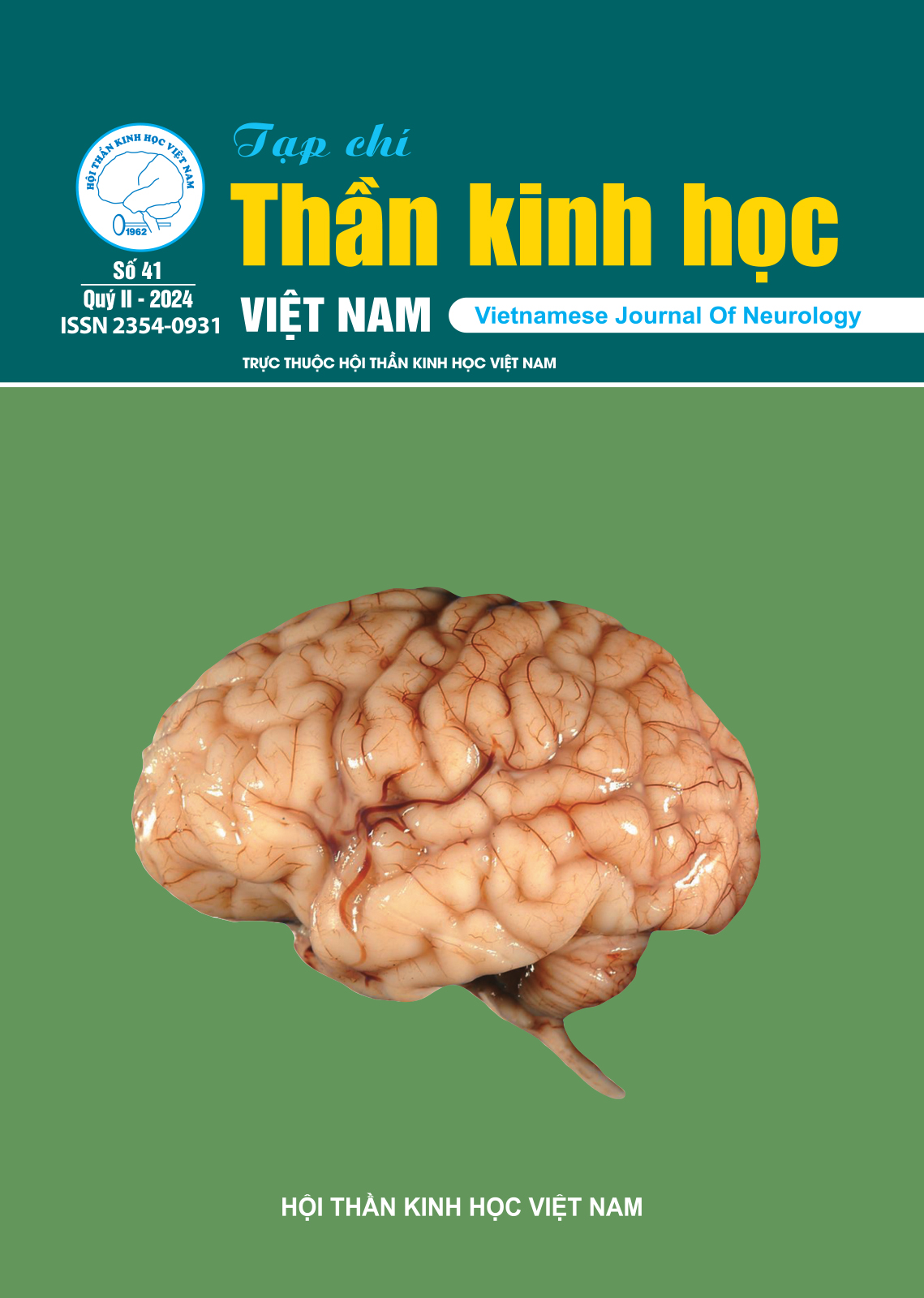So sánh giá trị của siêu âm xuyên sọ và cộng hưởng từ mạch máu não trong chẩn đoán hẹp động mạch nội sọ do xơ vữa ở bệnh nhân nhồi máu não cấptại bệnh viện Quân y 175

DOI:
https://doi.org/10.62511/vjn.41.2024.017Từ khóa:
siêu âm doppler xuyên sọ hẹp động mạch nội sọ nhồi máu não cấp trên lều và dưới lềuLượt tải xuống
Đã xuất bản
Số tạp chí
Chuyên mục
Thể loại
Cách trích dẫn
Tóm tắt
Mục tiêu: So sánh giá trị của siêu âm xuyên sọ (TCD) và cộng hưởng từ mạch máu não (MRA) trong chuẩn đoán hẹp động mạch nội sọ do xơ vữa ở bệnh nhân nhồi máu não cấp.
Phương pháp: Nghiên cứu loạt ca mô tả cắt ngang thực hiện tại khoa Nội Thần kinh, bệnh viện Quân Y 175, từ tháng 6 năm 2022 đến tháng 6 năm 2023, người tham gia là bệnh nhân được chẩn đoán nhồi máu não cấp trên và dưới lều. Bệnh nhân đủ tiêu chuẩn chọn mẫu sẽ được làm TCD và MRA với khoảng cách thời gian giữa 2 kỹ thuật này không quá 24h. Chúng tôi đánh giá độ nhậy, độ đặc hiệu, giá trị tiên đoán âm, giá trị tiên đoán dương, chỉ số Kappa của TCD so với MRA.
Kết quả: Chúng tôi đã thu nhận được 227 người bệnh nhồi máu não cấp có hẹp động mạch nội sọ. Độ nhậy, độ đặc hiệu, giá trị tiên đoán âm, giá trị tiên đoán dương, chỉ số Kappa của TCD với MRA lần lượt trên các động mạch. Động mạch não giữa MCA là 98.9%, 97.7%, 99.2%, 96.8%, 0.8; động mạch não trước 100%,99.5%,100%,94.4%,0.82; động mạch cảnh trong đoạn nội sọ 96.1%, 99.4%, 98.8%, 98%, 0.75; động mạch não sau 100%, 99.5%, 100%, 93.7%, 0.82; động mạch đốt sống 95.6%, 99.5%, 99.5%, 95.6%, 0.75; động mạch thân nền 95.2%, 99.5%, 99.5%, 95.2%, 0.78.
Kết luận: Sử dụng kỹ thuật siêu âm xuyên sọ trong chẩn đoán hẹp động mạch nội sọ và theo dõi tình trạng hẹp động mạch nội sọ là phương pháp an toàn, rẻ tiền, không xâm lấn, độ chính xác tương đối cao so với MRA.
Tài liệu tham khảo
Nguyễn Bá Thắng (2011), "TƯỚI MÁU NÃO VÀ TƯƠNG QUAN VỚI TỔN THƯƠNG THIẾU MÁU NÃO". Bài giảng,.

Nguyễn Thị Bích Hường (2015), "Vai trò của siêu âm xuyên sọ trong chẩn đoán hẹp động mạch nội sọ ở bệnh nhân nhồi máu não cấp trên lều,". Y Học TP. Ho Chi Minh, 19- Supplement of No 1, pp. 251-257.

Mai Duy Tôn (2023),“Kết quả điều trị nhồi máu não cấp và yếu tố tiên lượng tử vong tại một số đơn vị đột quỵ não ở Hà Nội”. Tạp chí nghiên cứu y học.

Nguyễn Huy Thắng (2012), "Điều trị thuốc tiêu sợi huyết rTPA đường tĩnh mạch trên bệnh nhân nhồi máu não cấp trong 3 giờ đầu". Luận án Tiến sĩ y học, Đại học Y Dược Thành Phố Hồ Chí Minh.

Nguyễn Thị Kim Liên (2013), "Hiệu quả và độ an toàn của rTPA trên bệnh nhân thiếu máu não cấp khởi phát từ 3-4,5 giờ". Y Học TP.Hồ Chí Minh, 17 (1), pp. 170-176.

Adams H. P., Jr., Brott T. G., Crowell R. M., Furlan A. J., Gomez C. R., et al. (1994), "Guidelines for the management of patients with acute ischemic stroke. A statement for healthcare professionals from a special writing group of the Stroke Council, American Heart Association". Circulation, 90 (3), pp. 1588-601.
DOI: https://doi.org/10.1161/01.CIR.90.3.1588

Andrei V. Alexandrov MD RVT (2012), "Cerebrovascular Ultrasound in Stroke Preventian and Treatment,". Second edition.

Chimowitz M. I., Lynn M. J., Howlett-Smith H., Stern B. J., Hertzberg V. S., et al. (2005), "Comparison of warfarin and aspirin for symptomatic intracranial arterial stenosis". N Engl J Med, 352 (13), pp. 1305-16.
DOI: https://doi.org/10.1056/NEJMoa043033

Chung J. W., Park S. H., Kim N., Kim W. J., Park J. H., et al. (2014), "Trial of ORG 10172 in Acute Stroke Treatment (TOAST) classification and vascular territory of ischemic stroke lesions diagnosed by diffusion-weighted imaging". J Am Heart Assoc, 3 (4).
DOI: https://doi.org/10.1161/JAHA.114.001119

Derdeyn C. P., Chimowitz M. I., Lynn M. J., Fiorella D., Turan T. N., et al. (2014), "Aggressive medical treatment with or without stenting in high-risk patients with intracranial artery stenosis (SAMMPRIS): the final results of a randomised trial". Lancet, 383 (9914), pp. 333-41.
DOI: https://doi.org/10.1016/S0140-6736(13)62038-3

Feldmann E., Wilterdink J. L., Kosinski A., Lynn M., Chimowitz M. I., et al. (2007), "The Stroke Outcomes and Neuroimaging of Intracranial Atherosclerosis (SONIA) trial". Neurology, 68 (24), pp. 2099-106.
DOI: https://doi.org/10.1212/01.wnl.0000261488.05906.c1

Guan J., Zhou Q., Ouyang H., Zhang S., Lu Z. (2013), "The diagnostic accuracy of TCD for intracranial arterial stenosis/occlusion in patients with acute ischemic stroke: the importance of time interval between detection of TCD and CTA". Neurol Res, 35 (9), pp. 930-6.
DOI: https://doi.org/10.1179/1743132813Y.0000000230

Haines D.E. External Morphology of the Central Nervous System (2004), "Neuroanatomy – An Atlas of Structures, Sections, and Systems". Lippincott Williams & Wilkin, 6th ed, pp. 9-54.

Hendelman WJ Neurological neuroanatomy - Vascular supply (2006), "Atlas of functional neuroanatomy". Taylor & Francis Group, 2nd edition, pp. 156-201.
DOI: https://doi.org/10.1201/9781420037814.ch3

Jovin TG. Demchuk AM., Gupta R., Pathophysiology Of Acute Ischemic Stroke , (2008), "Continuum Lifelong Learning in Neurology ". pp. 28-45.
DOI: https://doi.org/10.1212/01.CON.0000275639.07451.e7

Kolominsky-Rabas P. L., Weber M., Gefeller O., Neundoerfer B., Heuschmann P. U. (2001), "Epidemiology of ischemic stroke subtypes according to TOAST criteria: incidence, recurrence, and long-term survival in ischemic stroke subtypes: a population-based study". Stroke, 32 (12), pp. 2735-40.
DOI: https://doi.org/10.1161/hs1201.100209

Martin Roubec et al (2011), "Detection of intracranial arterial stenosis stenosis using transcranial color- coded duplex sonography, computed tomographic angography, and digital subtraction angiography". J Ultrasound Med, pp. 451-45.
DOI: https://doi.org/10.7863/jum.2011.30.8.1069

Mattioni A., Cenciarelli S., Eusebi P., Brazzelli M., Mazzoli T., et al. (2020), "Transcranial Doppler sonography for detecting stenosis or occlusion of intracranial arteries in people with acute ischaemic stroke". Cochrane Database Syst Rev, 2 (2), pp. Cd010722.
DOI: https://doi.org/10.1002/14651858.CD010722.pub2

Netter F.H. Craig J.A., Perkins J., Hansen J.T., Koeppen B.M., Neuroanatomy, (2002), "Atlas of Neuroanatomy and Neurophysiology, Selections from the Netter Collection of Medical Illustrations, ". Icon Custom Communications Ed., pp. 1-50.

Pendlebury S. Giles M., Rothwell P., Causes of transient ischemic attack and ischemic stroke, (2009), "Transient ischemic attack and stroke: diagnostic investigation and mangagement. ". Cambridge University Press. Cambridge, New York, Melbourne, Madrid, Cape Town, Singapore, São Paulo., pp. 55-90.
DOI: https://doi.org/10.1017/CBO9780511575815.007

Rohkamm R. Cerebral circulation (2004), " Color atlas of neurology". Thieme ed.Stuttgart New York, pp. 10-17.
DOI: https://doi.org/10.1055/b-005-148923

Silverman I.E. Rymer M.M. (2009), "An Atlas of Investigation and Treatment in Ischemic Stroke,". Clinical Publisshing ed., , Oxford, .










